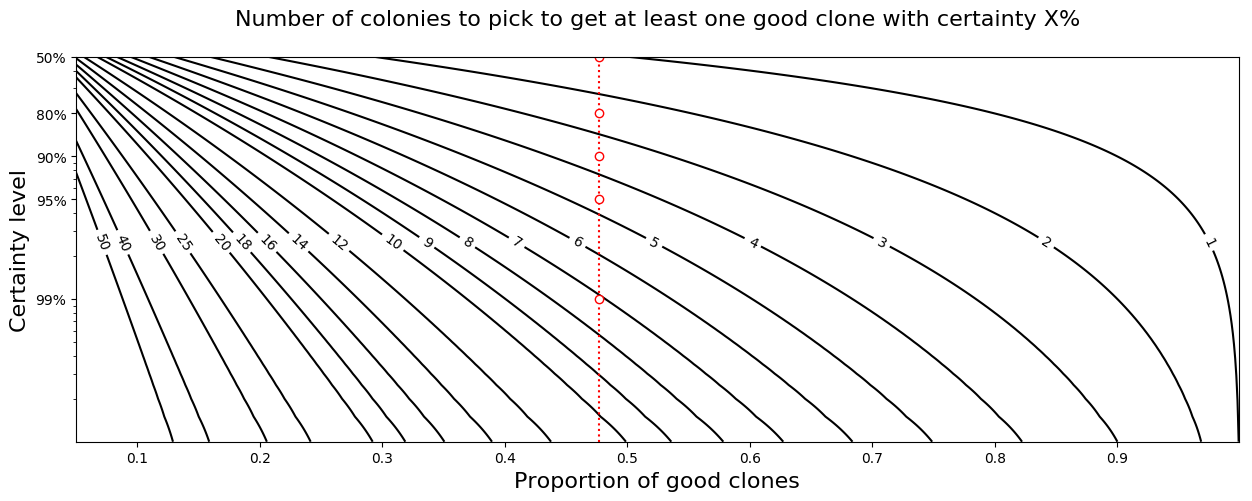Kappagate is a Python library to predict the percentage of good clones (carrying a correct version of the desired assembly) when assembling DNA with a method relying on 4bp overhangs (e.g. Golden Gate assembly, OGAB, etc.).
Using Kappagate, you can get an estimation of how difficult the assembly will be, and how many clones should be tested to find a correct one.
Kappagate uses the exhaustive relative overhang affinity tables provided in Potapov et. al. 2018 (ACS Syn. Bio.). In this publication the authors show that the proportion of valid clones rates can be predicted using focused in-vitro experiments focused on the overhangs present in the assembly.
Kappagate attempts to predict clone validity rates without any overhang-subset-specific experiment, using computer simulations instead. It simulates the temporal evolution of the DNA fragments ligation reaction using the Kappa biological modeling system. At the end of the cloning simulation, Kappagate returns the ratio between "good" constructs (with all expected parts in the right order) and bad circular assembly-forming constructs (which may produce bad clones after transformation and plating).
This is an experimental piece of software, useful to us, but coming with no warranty.
from kappagate import predict_assembly_accuracy, overhangs_list_to_slots
# FIRST TEST ON 12 WELL-DESIGNED OVERHANGS
overhangs= ['GGAG', 'GGCA', 'TCGC', 'CAGT', 'TCCA',
'GAAT', 'AGTA', 'TCTT', 'CAAA', 'GCAC',
'AACG', 'GTCT', 'CCAT']
slots = overhangs_list_to_slots(overhangs)
predicted_rate, _, _ = predict_assembly_accuracy(slots)
print (predicted_rate)
# >>> 0.987This means that 98.7% of clones will carry a valid assembly. It is really not far from the experimental observation in Potapov et al., which was 99.2% +- 0.6% (1 std). Let's have a look at a few more sets:
overhangs = ['GGAG', 'GATA', 'GGCA', 'GGTC', 'TCGC',
'GAGG', 'CAGT', 'GTAA', 'TCCA', 'CACA',
'GAAT', 'ATAG', 'AGTA', 'ATCA', 'TCTT',
'AGGT', 'CAAA', 'AAGC', 'GCAC', 'CAAC',
'AACG', 'CGAA', 'GTCT', 'TCAG', 'CCAT']
slots = overhangs_list_to_slots(overhangs)
predicted_rate, _, _ = predict_assembly_accuracy(slots)
print (predicted_rate)
# >>> 0.846
# In Potapov 2018: 84% +/- 5%overhangs= ['GGAG', 'GGTC', 'AGCA', 'CAGT', 'GGTA',
'GAAT', 'GGTT', 'TCTT', 'GGTG', 'GCAC',
'AGCG', 'GTCT', 'CCAT']
slots = overhangs_list_to_slots(overhangs)
predicted_rate, _, _ = predict_assembly_accuracy(slots)
print (predicted_rate)
# >>> 0.33
# In Potapov 2018: 45% +/- 5%To plot the parts circularly with their interaction:
from kappagate import overhangs_list_to_slots, plot_circular_interactions
overhangs = ['TAGG', 'GACT', 'GGAC', 'CAGC',
'GGTC', 'GCGT', 'TGCT', 'GGTA',
'CGTC', 'CTAC', 'GCAA', 'CCCT']
slots = overhangs_list_to_slots(overhangs)
ax = plot_circular_interactions(
slots, annealing_data=('25C', '01h'), rate_limit=200)
ax.figure.savefig("test.png", bbox_inches='tight')The unwanted overhang interactions appear in red in the resulting figure:
To convert the predicted success rate into decisions regarding how many colonies to pick, and when to stop picking colonies:
from kappagate import (overhangs_list_to_slots, predict_assembly_accuracy,
plot_colony_picking_graph, success_rate_facts)
overhangs = ['TAGG', 'GACT', 'GGAC', 'CAGC',
'GGTC', 'GCGT', 'TGCT', 'GGTA',
'CGTC', 'CTAC', 'GCAA', 'CCCT']
slots = overhangs_list_to_slots(overhangs)
predicted_rate, _, _ = predict_assembly_accuracy(slots)
ax = plot_colony_picking_graph(success_rate=predicted_rate)
ax.figure.savefig("success_rate_facts.png", bbox_inches='tight')
print (success_rate_facts(predicted_rate, plain_text=True))Result:
The valid colony rate is 47.7%. Expect 1.9 clones in average
until success. Pick 5 clones or more for 95% chances of at
least one success. If no success after 8 clones, there is
likely another problem (p-value=0.01).
You can install kappagate through PIP
sudo pip install kappagate
Alternatively, you can unzip the sources in a folder and type
sudo python setup.py install
Kappagate is an open-source software originally written at the Edinburgh Genome Foundry by Zulko and released on Github under the MIT licence (Copyright 2018 Edinburgh Genome Foundry).
Everyone is welcome to contribute !

Kappagate is part of the EGF Codons synthetic biology software suite for DNA design, manufacturing and validation.


